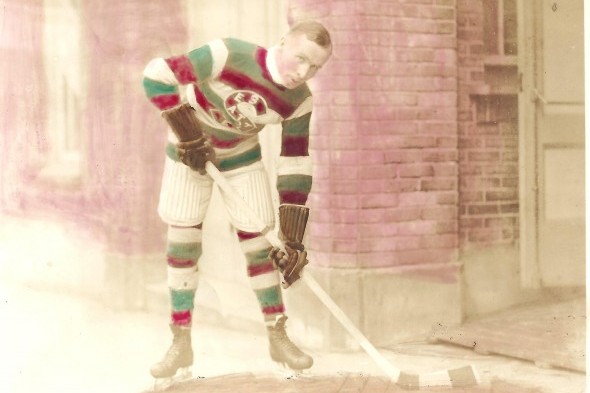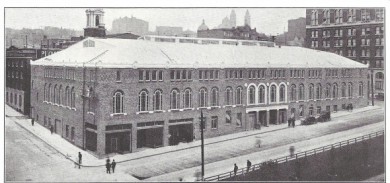
The 1916-1917 Seattle Metropolitans of the Pacific Coast Hockey Association were the first U.S team to win The Stanley Cup, defeating the National Hockey Associations Montreal Canadiens three games to one.
Frank “The Flash” Foyston, shown above in Seattle’s distinctive barber-pole uniform, helped the Metropolitans claim hockey’s ultimate prize in an exhilarating four-game series against the Montreal Canadiens — the first time a U.S. team won the Cup.
During the 1917 title series, Foyston scored six goals and was a constant menace around the Montreal goal. At season’s end, he was voted to the right wing position on the Pacific Coast Hockey Association First All-Star Team.
The 1917 Finals took place in the Seattle Ice Arena, a 2,500-seat facility built in 1915 and located across the street from what is now the Fairmont Olympic Hotel on University Street in downtown Seattle. The Metropolitans called the venue home through the 1924 season, at which point, due to to declining interest and attendance, it was remodeled into a parking garage. The building was torn down in 1967.

Two years after Foyston led the Metropolitans to the championship, he led Seattle into a Stanley Cup rematch with the Canadiens. The crafty forward scored an incredible eight goals in the first four matches of that series, which was abandoned because of the world-wide influenza pandemic. It proved to be the only year in which the Stanley Cup wasn’t awarded.
The 1917 Metropolitans included three Hockey Hall of Fame players. In addition to Foyston, who entered the Hall in 1958, rover Jack Walker entered in 1960 and Harry “Hap” Holmes in 1972. The Mets’ goalkeeper, Holmes posted a 3-1 record in the 1917 Finals, with a 2.75 goals-against average.
The coach of the 1917 Metropolitans, Pete Muldoon, also had an enduring celebrity of sorts, although not entirely for his work in Seattle. A decade after leading the Metropolitans to the Stanley Cup, Muldoon lost his job as head coach of the Chicago Black Hawks (their name then) after his team failed to finish in first place. When club owner Major Frederic McLaughlin fired him, Muldoon reportedly placed a curse on McLaughlin’s franchise, insisting it would never again finish in first place. The “Curse of Muldoon”, later proved to be a media fabrication, nevertheless gained traction because the Black Hawks did not finish in first place (regular season) until 1967.
Born in Minesing, Ontario, Foyston played professional hockey for 16 years, including nine with Seattle (played in 249 games, scoring 139 goals with 24 assists). He also played for the Toronto Blueshirts of the NHA, the Victoria Cougars in the WCHL/WHL and for the Detroit Cougars in the NHL.
Foyston won the Stanley Cup with Toronto in 1914, again in 1917 with Seattle, and for a third time in 1925 with Victoria. He is one of only ten players in history to win Stanley Cups with three different teams.
Foyston coached for seven years after his playing days, including four years with the Seattle Sea Hawks of the Northwest Hockey League.
After his playing, scouting and coaching careers, Foyston operated a turkey farm in Port Orchard, WA. He died on Jan. 19, 1966, and is interred at Evergreen-Washelli Memorial Park in Seattle.
Sports historian David Eskenazi can be reached at (206) 441-1900, or at seattlesportshistory@gmail.com
(Wayback Machine is published every Tuesday as part of Sportspress Northwests package of home-page features collectively titled, The Rotation.)

12 Comments
If Seattle ever gets a NHL team those would be some impressive throw-back jerseys.
Interesting…it will be fun to see if he can sustain those numbers playing USC, OR and Stanford instead of EWU and HI.
You are right. Keep in mind that UW quarterbacks of the past also faced some cupcakes in early games.
“12.5 percent of Prices 122 throws have resulted in touchdowns (3 vs.
Eastern Washington, 4 vs. Hawaii, 3 vs. Nebraska, 3 vs. California).”
3+4+3+3 != 14
He threw for 4 TDs vs. Nebraska as well as vs. Hawaii.
It will be interesting to see if Price can maintain these numbers. Thanks for reading!
Montana may want to transfer. These numbers are remarkable!
Quite remarkable. Thank you for visiting our web site.
As much as I like the way Locker finished last year, I always had problems with his lack of touch and accuracy passing the ball. We kept waiting for him to “finally get it”, but he never really did. He became a better quarterback last year, but his passing was still average at best. They always said he had “a canon for an arm”, but canons are not the most accurate of weapons.
How many times did we see receivers as open as Polk was on his touchdown reception Saturday, only to see Jake sail the ball 4 or 5 yards over their heads? But he made up for this with his athleticism and his leadership. The Denver Broncos have a similar athlete on their roster who’s currently their 3rd string quarterback.The Huskies finally have a quarterback who’s throwing ability is not a liability. In fact, his only liability seems to his physical size — compared to most quarterbacks, he is on the short side — around 6′ tall. But when he is on the field the Husky offense seems to move almost effortlessly down the field. Like Locker, he appears to possess those intangible qualities such as leadership. He also smiles a lot too, which gives the play by play guys something to comment on when the camera pans the sidelines. This might be the beginning of something special.
Thank you for visiting our web site!
The “Price” is right!! Go Keith! I love you cousin! Also, how come we can’t find his jersey anywhere? What’s up with that?
I have always stated that Jake Locker was a great athete at UW, but not that great of QB in the sense of what that position is suppose to be. And certainly he wouldn’t be Coach Sark’s first choice, if both showed up on the same day, as Jake came from a high school that ran a form of the Veer offense. He was not a passing QB in high school. Price, to my surprise, seems to be a more typical QB type and a much better passer, considering Nick Montana can’t pass him in the depth charts. At 6’1″ I don’t feel Price is that short if you compare him to Drew Breeze and such QB’s in the NFL. He could stand to put a few more pounds on the body though.
Also in the interest of accuracy, it’s worth noting that when Charlie Browning was drafted by the NFL, it was as a halfback. And whattya know–he was a running back at UW, not a quarterback.